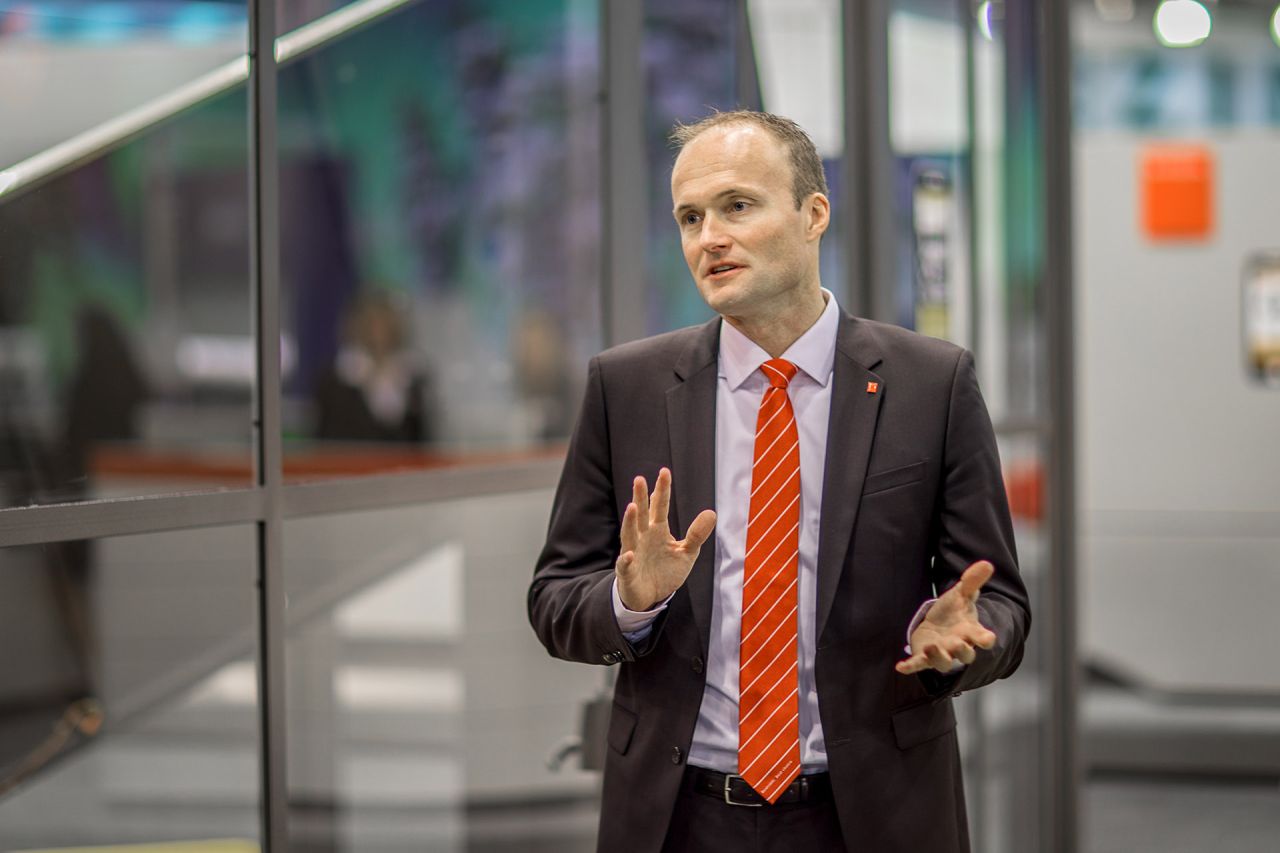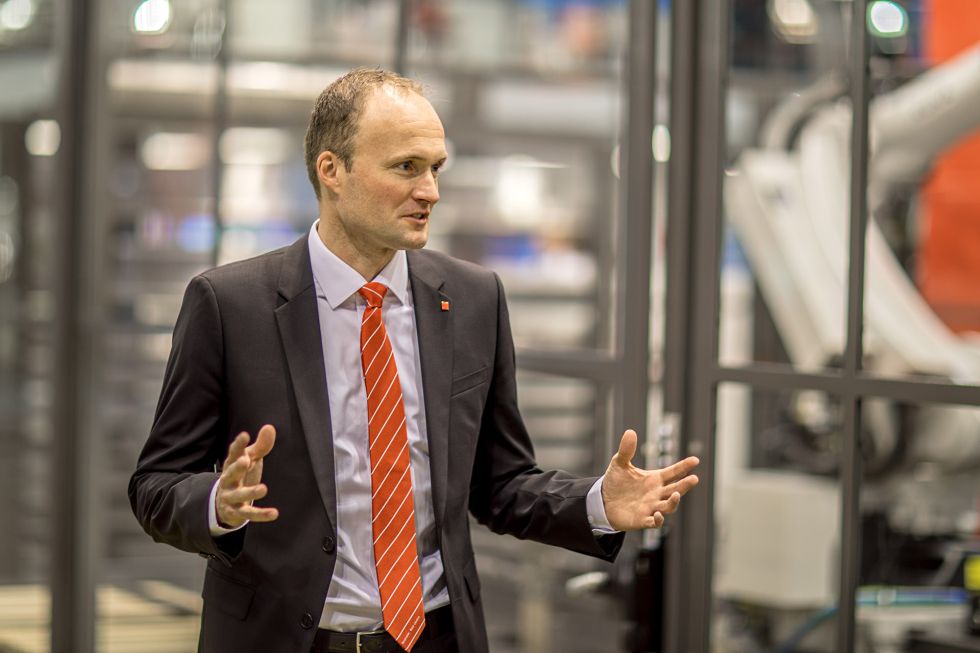
News “The perfect interplay between hardware and software”
Dr. Rüttimann, what is Bystronic’s view on the smart factory?
Our focus is always on our customers. We want to enable them to be successful at the forefront of the competition – regardless of whether they produce small batches or large series. Our vision is to be able to offer a smart factory that makes this possible, where all processes from the initial order inquiry to the delivery of the metal sheets right through to the shipping of the finished parts are automated. Software, of course, is a key element. But the machines are also becoming faster and more precise. And in order for the concept of autonomous production to work, machines must operate with absolute reliability and a high degree of availability. The perfect interaction of hardware and software enables economic efficiency to be increased further.
How will the relationship between software, digital networking, and mechanics develop in the future?
At the moment, the main focus is still on the mechanics. I expect that this will remain the case for a few more years, but certainly not for the next decade. In the long term, software will be the dominating component.
Is the smart factory really already feasible?
The smart factory is our vision. We accompany our customers step by step on the path towards it. The first step is to collect the necessary data, evaluate it efficiently, and display it in a clear and concise manner – for example using our ByCockpit monitoring solution. This helps customers make decisions, optimize processes, and take preventive action if necessary. But this is only an interim step on the path towards an autonomous factory in which the data is used automatically in order to control processes.
What is Bystronic’s current state of progress on the road to the smart factory?
Like all our competitors on the market, we are still at the early stages of this development. The market we serve is still strongly defined by smaller companies, such as job shops, whose focus is still on individual machines or automated cells. In this respect, the market also sets the pace. We already offer end-to-end solutions that are automated, but not yet fully networked with the environment. Of course, we also use such systems in our own production. This is important for further development, but also in order to convince our customers.
What are the next steps with which the vision is to be implemented?
We view this as a four-phase process that begins with automation and digital networking. The second phase involves establishing connectivity between the systems in order to exchange and collect data, which we then analyze and evaluate in the third phase in order ultimately to be able to offer new services via a platform. However, this is not a sequential process, but runs in parallel for individual applications. In the near future, we want to be able to offer a fully automated smart factory solution in which all components are coordinated, the production flow is optimized, and machines from other suppliers can also be integrated. To achieve this, we are consistently expanding our software expertise.
Shouldn’t such a platform be open and capable of networking with others?
Absolutely. The system has to be modular and structured in a way that ensures connectivity and that makes it comparatively simple to respond in the event of changing requirements. However, another important aspect is to choose the right partner to provide the necessary cloud solution.
What role does artificial intelligence play?
AI is playing an increasingly important role, for example for self-optimizing subsystems in machines. However, in this respect mechanical engineering is still in its infancy. We are already equipping our cutting, bending, and automation systems so they can be retrofitted accordingly in the future.
What modules does Bystronic already offer in order to start building a smart factory?
We are active along the value chain of our customers. Within this framework, we offer modular, flexible solutions that can be combined as required. This ranges from the procurement and management of raw materials through to warehousing, intralogistics, and automated cutting and bending. A wide range of consulting, financing, and maintenance services relating to these processes rounds off our portfolio.
For which users are such systems relevant and beneficial?
The benefits are the same for everyone. It is all about manufacturing high-quality products in a cost-effective and flexible manner. On the market, we are seeing that smaller companies are joining forces, for example during the course of succession planning or because there are not enough skilled specialists and the only option is to automate. Of course, it is easier for large companies to come up with the funds for the necessary investments. However, in the next step, smaller companies will also benefit.
What requirements must prospective customers meet in order to benefit?
They should have a concrete goal, a clear vision. During discussions with potential customers, we frequently see that they do not yet have a precise idea of what they can achieve. If the systems are precisely synchronized, it ultimately doesn’t matter whether the customer produces mass products or small batches. The machines can be networked, that is not a problem. But when it comes to the question of how upstream and downstream processes should be integrated, a clear picture is indispensable. This is why we offer our customers detailed advice on the path towards the smart factory. We thus show them what could be possible in their production environment in the future.
Are companies actually prepared to open up and share their data?
In our experience, the clearer the benefits for our customers are, the greater their willingness is to share data. Particularly because of our customers’ increasing understanding of the fact that the machine data we need does not allow any conclusions to be drawn about their process know-how. Our customers’ trust is key. The more data they share with us, the better the solutions we will be able to offer them in the future.
How has customer interest been so far?
It depends strongly on the customers’ corporate culture and openness. We see both: Some customers continue to focus on the machines, but there is also an increasing openness towards sharing data. Simply because more and more customers are recognizing the benefits.
Is the concern that this technology will cost jobs justified?
Not in my opinion. The jobs will certainly change. Some fields of work will disappear, but in return, new job profiles will emerge. So far, every industrial revolution has created more new jobs than it cost.
With what philosophy is Bystronic supporting the development of the smart factory?
When developing our manufacturing solutions, we are open to the integration of external or third-party suppliers. In this way we want to offer our customers the greatest possible level of flexibility. To compare our philosophy to smartphone operating systems, our approach is more like open systems such as Android than Apple’s proprietary iOS.
